NASA Image of the Day, JPL News Month in Review, Total Solar Eclipse, and Announces 2021 Class of Astronaut Candidates, Part 1
NASA Image of the Day
NASA’s Jet Propulsion Laboratory – Thursday, December 2, 2021, MONTH IN REVIEW
What’s UP – December 2021,
Are Water Plumes Spraying from Europa? NASA’s Europa Clipper Is on the Case, Nov 30, 2021
NASA’s Curiosity Rover Sends a Picture Postcard from Mars, Nov 23, 2021
New Deep Learning Method Adds 301 Planets to Kepler’s Total Count, Nov 22, 2021
NASA’s Perseverance Captures Challenging Flight by Mars Helicopter, Nov 18, 2021
One Year from Launch: US-European Satellite to Track World’s Water, Nov 17, 2021
Twin of NASA’s Perseverance Mars Rover Begins Terrain Tests, Nov 17, 2021
Live Feed of the Dec. 4, 2021 Total Solar Eclipse
Streamed live 23 hours ago 12.3.2021 NASA
NASA Announces 2021 Class of Astronaut Candidates
Streamed live on Dec 6, 2021 NASA
NASA Image of the Day
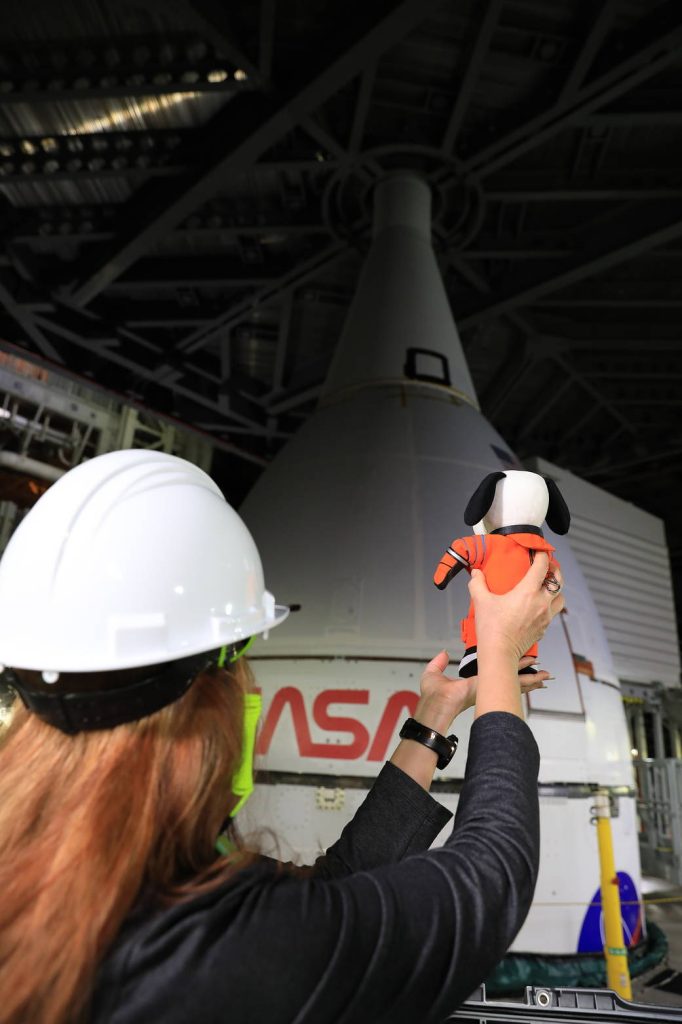 Snoopy to Fly Aboard Artemis I
Snoopy to Fly Aboard Artemis I
Snoopy, the Zero G Indicator for the Artemis I mission, was delivered to NASA’s Kennedy Space Center on Dec. 2 2021.
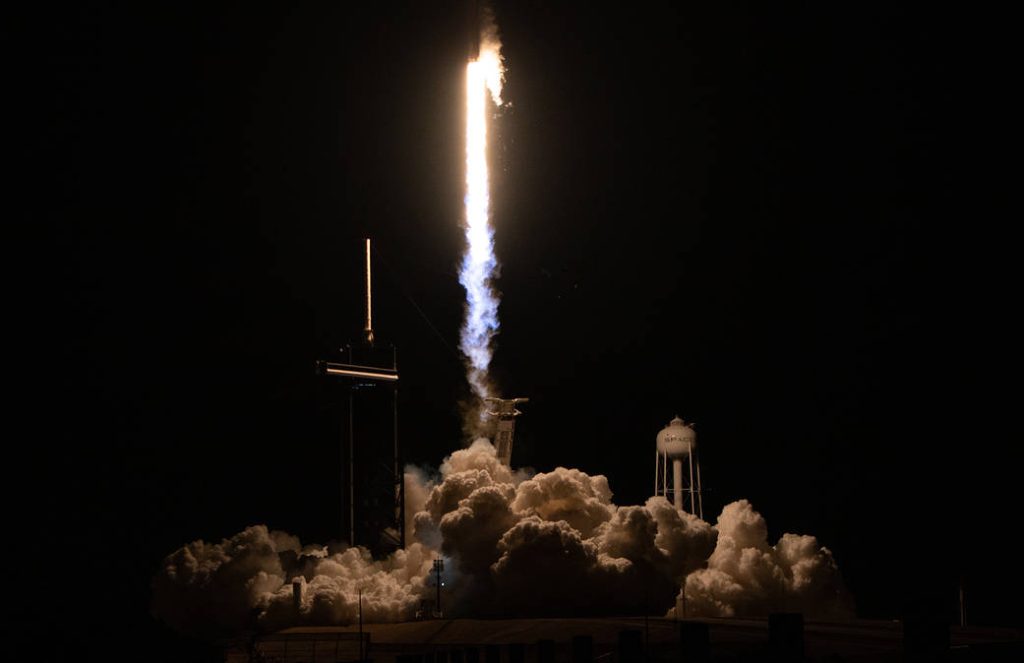
A SpaceX Falcon 9 rocket launches with NASA’s Imaging X-ray Polarimetry Explorer (IXPE) spacecraft onboard from Launch Complex 39A, Thursday, Dec. 9, 2021
This stunning image captures a small region on the edge of the inky Coalsack Nebula, aldwell
Exploring the Secrets of the Universe
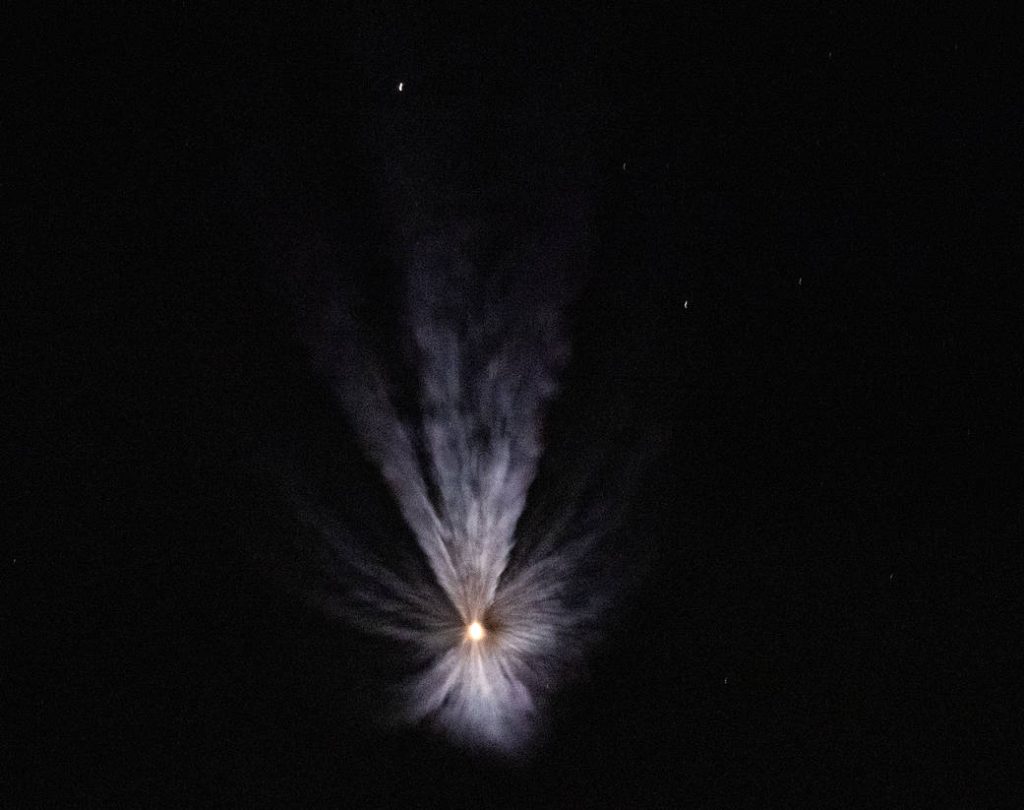
Laser Communications Relay Demonstration Lifts Off!
NASA’s Laser Communications Relay Demonstration, or LCRD, launched aboard a United Launch Alliance Atlas V rocket on Tuesday, Dec. 7, 2021.
This image of our home planet shows how Earth looked from more than 950,000 miles, or 1.5 million kilometers, away during the total solar eclipse visible in Antarctica on Dec. 4, 2021
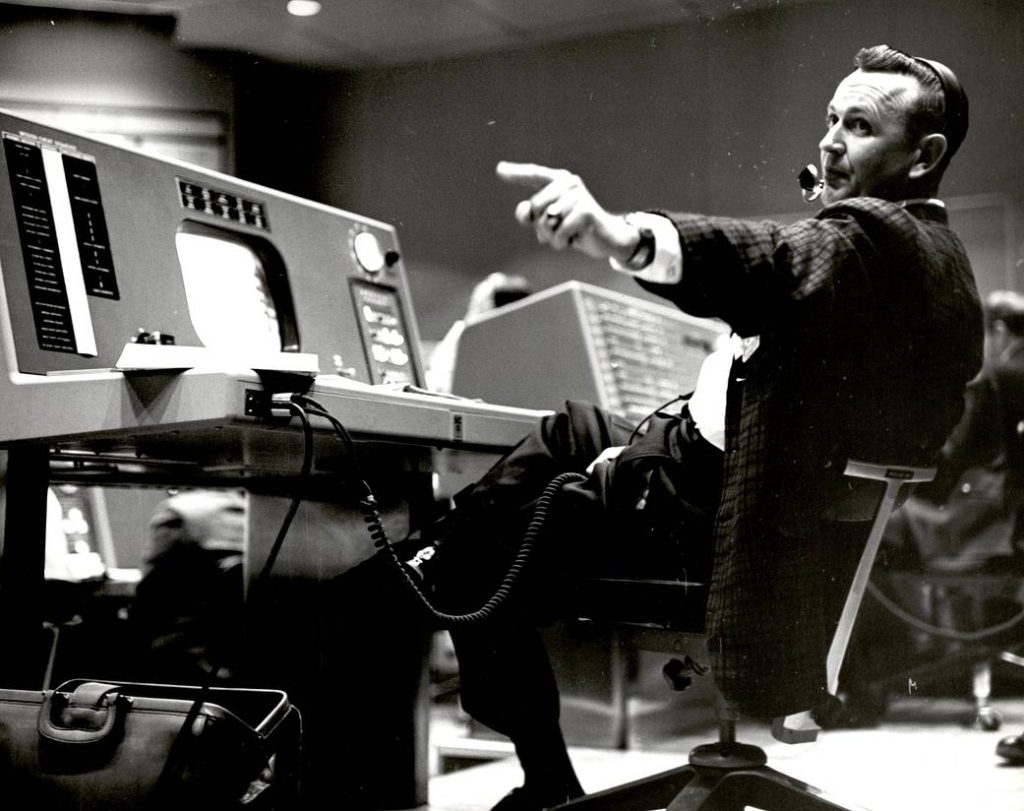 Become a Flight Director … And Perhaps a Legend
Become a Flight Director … And Perhaps a Legend
Christopher Kraft, flight director during Project Mercury, works at his console inside the Flight Control area at Mercury Mission Control.
NASA’s Curiosity Mars rover used its black-and-white navigation cameras to capture panoramas of this scene at two times of day on Nov. 16, 2021
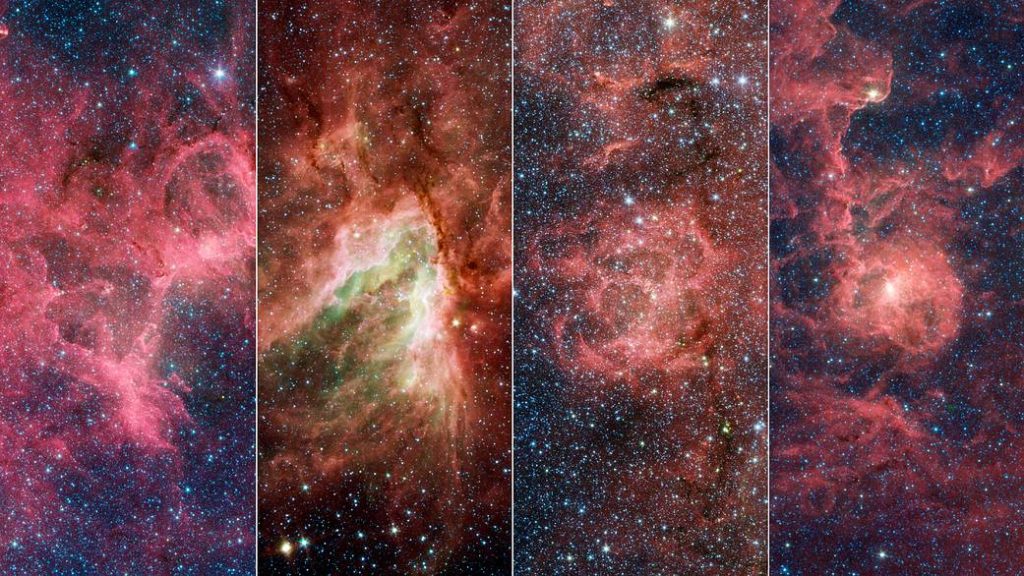 Eagle, Omega Nebula, Trifid, and Lagoon: Four Famous Nebulae
Eagle, Omega Nebula, Trifid, and Lagoon: Four Famous Nebulae
These four nebulae are known for their breathtaking beauty: the Eagle Nebula (which contains the Pillars of Creation), the Omega Nebula, the Trifid Nebula, and the Lagoon Nebula

Dragons-Eye View
As the Crew-2 mission departed the International Space Station aboard SpaceX Crew Dragon Endeavour, the crew snapped this image of the station.
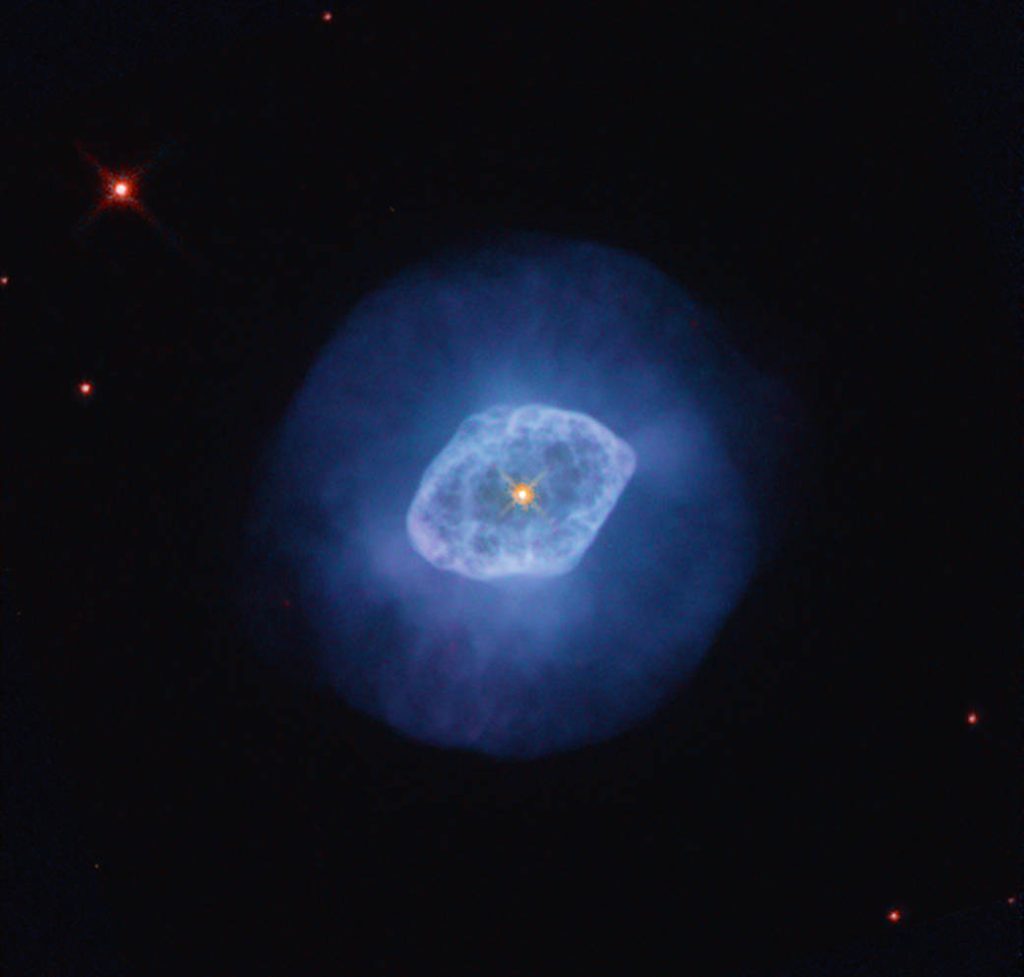 Hubble’s View of Planetary Nebula Reveals Complex Structure
Hubble’s View of Planetary Nebula Reveals Complex Structure
NGC 6891 is a bright, asymmetrical planetary nebula in the constellation Delphinus, the Dolphin
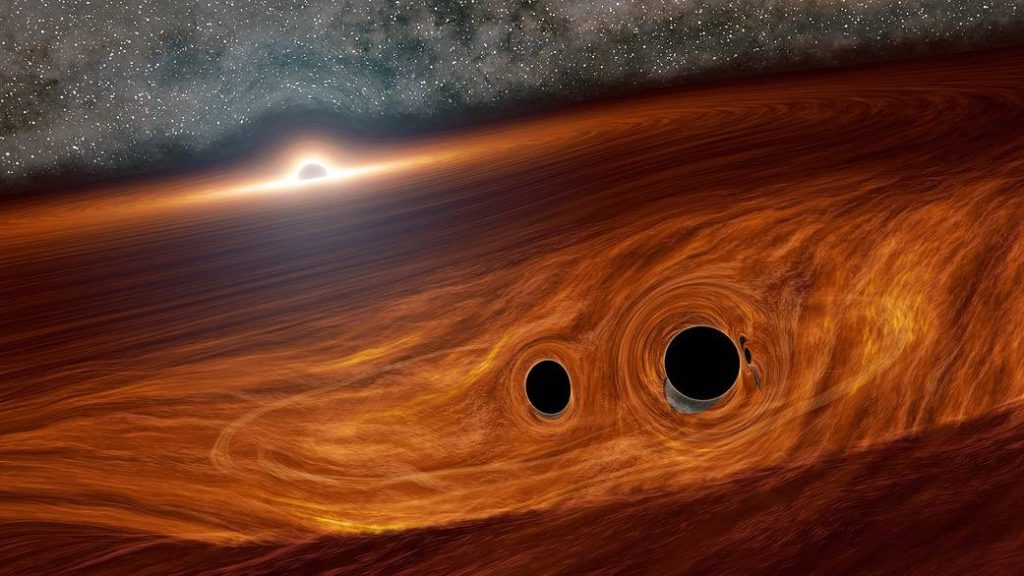 Black Hole Collision May Have Exploded with Light
Black Hole Collision May Have Exploded with Light
This artist’s concept shows a supermassive black hole surrounded by a disk of gas
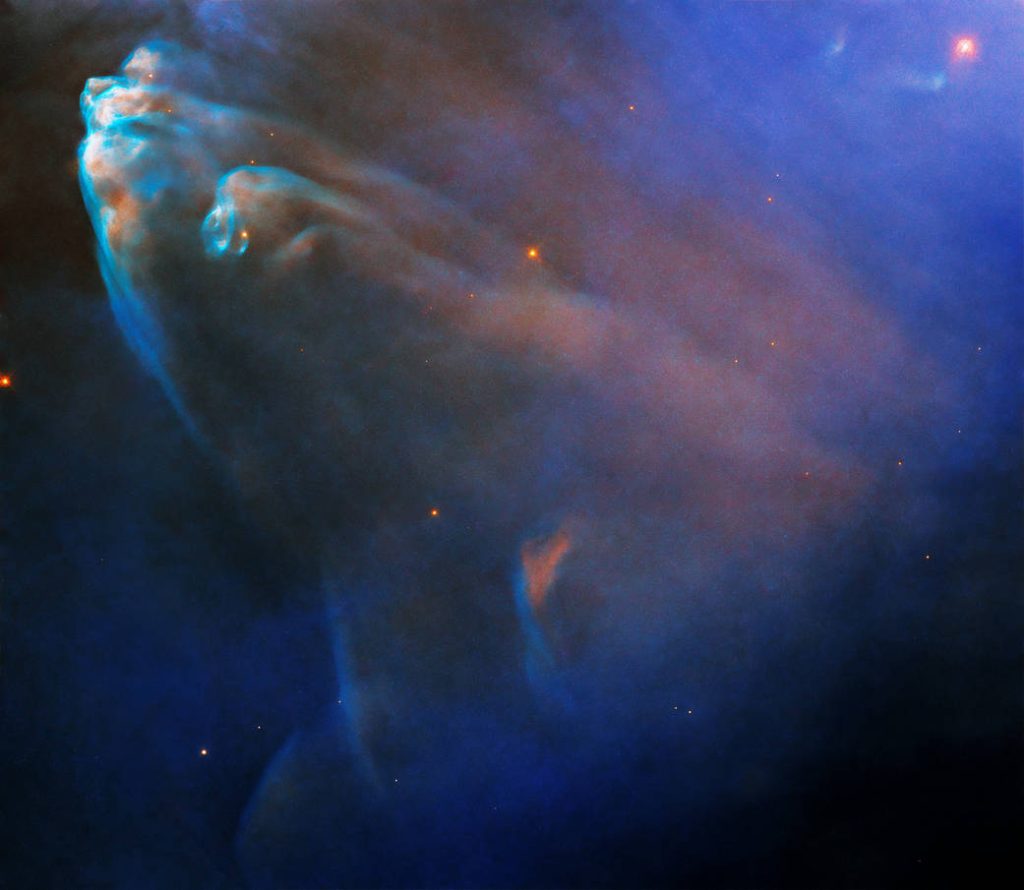 Hubble Witnesses Shock Wave of Colliding Gases in Running Man Nebula
Hubble Witnesses Shock Wave of Colliding Gases in Running Man Nebula
Mounded, luminous clouds of gas and dust glow in this Hubble image of a Herbig-Haro object known as HH 45.
The Double Asteroid Redirection Test (DART) will help determine if intentionally crashing a spacecraft into an asteroid is an effective way to change its course
For more information, please visit the following link:
https://www.nasa.gov/multimedia/imagegallery/iotd.html
Thursday, December 2, 2021 |
||
| MONTH IN REVIEW | ||
|
|
What’s Up – December 2021 December 2021 skywatching highlights: A string of sunset planets, a chance to spy 2021’s brightest comet, and the annual Geminid meteor shower won’t be completely squashed by a bright Moon. › Watch now |
What are some skywatching highlights in December 2021? See three planets after sunset, but say goodbye to Venus as the “Evening Star” at the end of the month. Then have a hunt for newly discovered Comet Leonard in the early morning through mid-month. Finally, get up early on Dec. 14 to watch for Geminid meteors after local moonset, around 2 a.m.
Transcript:
What’s Up for December? Your early evening highlights, a chance to catch a comet, and the annual Geminid meteors.
On December 6th through the 10th, look westward following sunset for the Moon visiting Venus, Saturn, and Jupiter in turn. The Moon’s crescent fills out as it appears higher in the sky each evening over the course of the week.
Enjoy the view of dazzling Venus as the “evening star” while it lasts, though. Our cloud-covered neighbor planet will sink ever closer to the horizon during the month, disappearing for most of us by New Years’. It’ll reappear in late January as a morning planet preceding the sunrise, and won’t be back in evening skies until December of next year.
Next in December, there’s a recently discovered comet on its way into the inner solar system that might be worth trying to observe. It’s known as Comet Leonard, and it will be at its closest to Earth on December 12th, just a couple of weeks before it reaches its closest distance from the Sun.
Now, comets are notoriously difficult to predict in terms of brightness and visibility. Comet Leonard is predicted to peak at a brightness that will probably require binoculars to spot it. There’s a chance it could be bright enough to see with the unaided eye, but again, with comets, you really never know.
In the first couple of weeks of December, Comet Leonard can be found in the east before sunrise, passing between Arcturus and the handle of the Big Dipper. It approaches the horizon right around the time of its closest approach to Earth, meaning it’ll likely be brighter but more challenging to observe. It then switches over to being an evening object after around Dec. 14th, for just a little while after the Sun sets – as it begins its long haul outward from the Sun again, progressively fading in brightness.
Finally, the Geminid meteors are a highlight of December skies each year. This year’s meteor shower peaks overnight on December 13th and 14th. Apart from the weather, the phase of the Moon is usually the main factor in whether a meteor shower will have good viewing any given year. This year, the Moon will be almost 80% full at the peak of the Geminids, which isn’t ideal. However, that bright Moon will set somewhere around 2 a.m. wherever you’re located, leaving a couple of hours for meteor watching before dawn.
The meteors appear to radiate from the constellation Gemini, which you’ll find high in the west. Now while most annual meteor showers are caused by Earth passing through trails of dust-sized particles of comet debris, the Geminids are one of the few meteor showers that are caused by debris from an asteroid that crosses Earth’s orbit – in this case, one called Phaethon.
Recently, NASA scientists shared findings that suggest the difference between an asteroid and a comet might be less clear than we realized, with fizzing sodium on Phaethon playing the same role as vaporizing ice on comets.
And whether you catch a glimpse of Comet Leonard, or meteors from Asteroid Phaethon, both are reminders of the deep connections between Earth and the rest of the solar system that we discover because we look outward, and we explore.
Here are the phases of the Moon for December. You can catch up on all of NASA’s missions to explore the solar system and beyond at nasa.gov. I’m Preston Dyches from NASA’s Jet Propulsion Laboratory, and that’s What’s Up for this month.
What’s Up: December 2021 Skywatching Tips from NASA 3:19
Dec 2, 2021 NASA Jet Propulsion Laboratory
What are some skywatching highlights in December 2021? See three planets after sunset, but say goodbye to Venus as the “Evening Star” at the end of the month. Then have a hunt for newly discovered Comet Leonard in the early morning through mid-month. Finally, get up early on Dec. 14 to watch for Geminid meteors after local moonset, around 2 a.m. Additional information about topics covered in this episode of What’s Up, along with still images from the video, and the video transcript, are available at https://solarsystem.nasa.gov/whats-up….
For more information, please visit the following link:
Are Water Plumes Spraying from Europa? NASA’s Europa Clipper Is on the Case
Nov 30, 2021
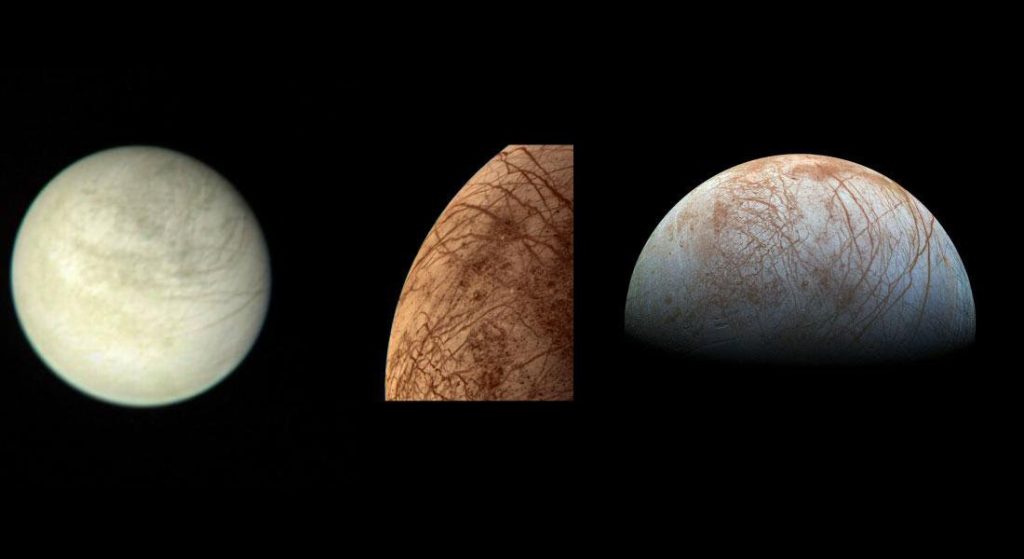 This triptych image shows views of Jupiter’s moon Europa as taken by various NASA spacecraft, including Voyager 1, Voyager 2 and Galileo.
This triptych image shows views of Jupiter’s moon Europa as taken by various NASA spacecraft, including Voyager 1, Voyager 2 and Galileo.
Credit: NASA/JPL-Caltech
Finding plumes at Europa is an exciting prospect, but scientists warn it’ll be tricky, even from up close.
In 2005, images of a brilliant watery plume erupting from the surface of Saturn’s moon Enceladus captivated the world. The giant column of vapor, ice particles, and organic molecules spraying from the moon’s south polar region suggested that there’s a liquid water ocean below Enceladus’ ice shell and confirmed the moon is geologically active. The plume also thrust Enceladus and other worlds in the outer solar system, with no atmospheres and far from the heat of the Sun, toward the top of NASA’s list of places to search for signs of life.
Scientists now are preparing for a mission to another ice-covered ocean world with possible plumes: Jupiter’s moon Europa. Scheduled to launch in 2024, NASA’s Europa Clipper spacecraft will study the moon from its deep interior to its surface to determine whether it has ingredients that make it a viable home for life.
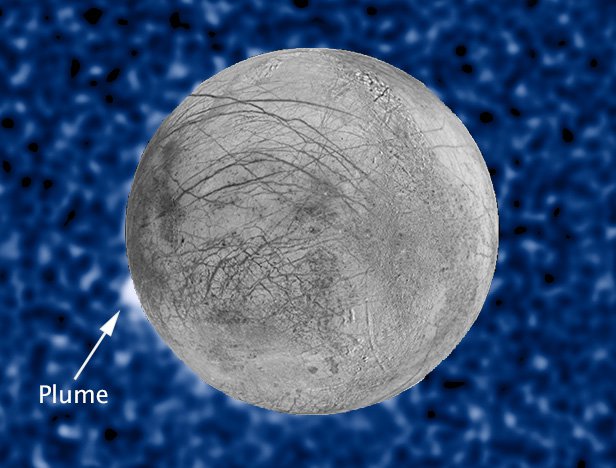 This composite image shows suspected plumes of water vapor erupting from Jupiter’s moon Europa. The image of the plume was made from data collected by NASA’s Hubble’s Space Telescope Imaging Spectrograph in 2014. The image of Europa itself is made from data from NASA’s Galileo and Voyager missions. Credit: NASA/ESA/W. Sparks (STScI)/USGS Astrogeology Science Center Full Image Details
This composite image shows suspected plumes of water vapor erupting from Jupiter’s moon Europa. The image of the plume was made from data collected by NASA’s Hubble’s Space Telescope Imaging Spectrograph in 2014. The image of Europa itself is made from data from NASA’s Galileo and Voyager missions. Credit: NASA/ESA/W. Sparks (STScI)/USGS Astrogeology Science Center Full Image Details
Like Enceladus, Europa is geologically dynamic, meaning both ice-covered moons generate heat inside as their solid layers stretch and flex from the gravitational tug-of-war with their host planets and neighboring moons. This, instead of heat from the Sun, keeps subsurface water from freezing. The heat may also help produce or circulate life’s chemical building blocks at their seafloors, including carbon, hydrogen, oxygen, nitrogen, phosphorus, and sulfur.
But that’s where the similarities end.
“A lot of people think Europa is going to be Enceladus 2.0, with plumes constantly spraying from the surface,” said Lynnae Quick, a member of the science team behind Clipper’s Europa Imaging System (EIS) cameras. “But we can’t look at it that way; Europa is a totally different beast,” said Quick, who’s based at NASA’s Goddard Space Flight Center in Greenbelt, Maryland.
Evidence suggests Europa may vent water from its subsurface just like Enceladus. For example, scientists using NASA’s Galileo spacecraft, NASA’s Hubble Telescope, and large Earth-based telescopes have reported detections of faint water plumes or their chemical components at Europa.
But no one is certain. “We’re still in the space where there’s really intriguing evidence, but none of it is a slam dunk,” said Matthew McKay Hedman, a member of Europa Clipper’s Mapping Imaging Spectrometer for Europa (MISE) science team and associate professor in the Department of Physics at the University of Idaho.
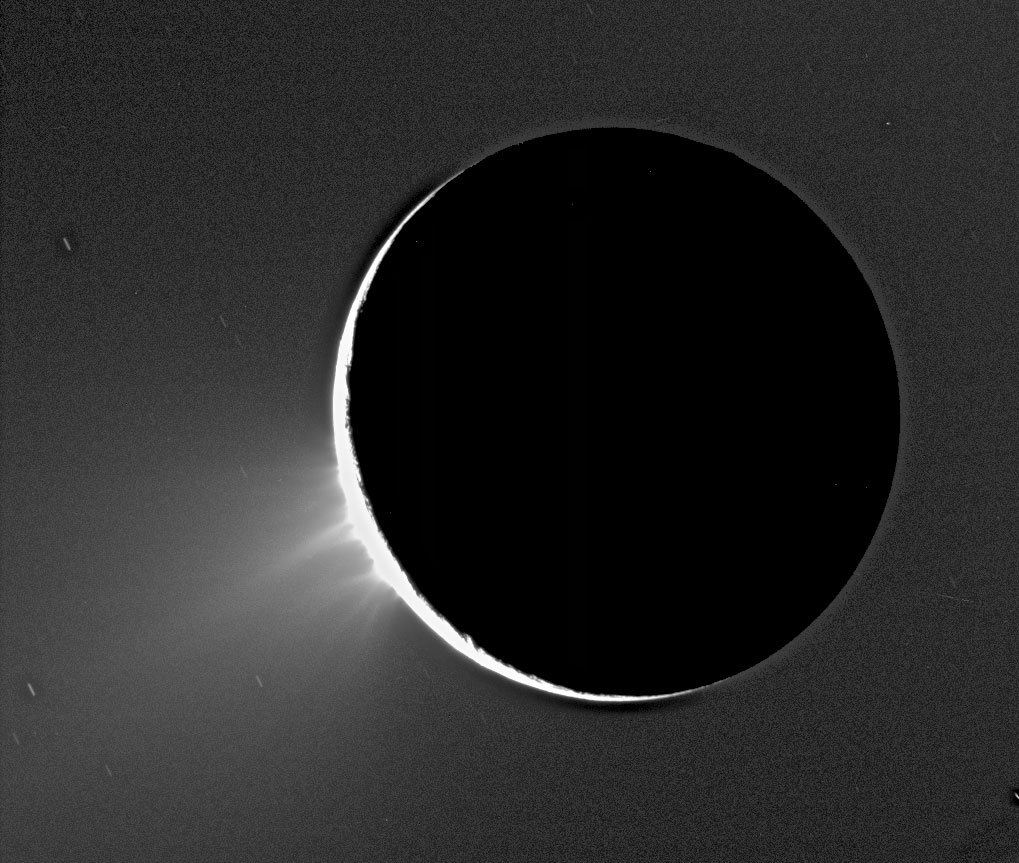 This image of the water jets at Saturn’s moon Enceladus was captured by NASA’s Cassini spacecraft on Nov. 27, 2005. Enceladus is backlit by the Sun. Credit: NASA/JPL-Caltech/Space Science Institute Full Image Details
This image of the water jets at Saturn’s moon Enceladus was captured by NASA’s Cassini spacecraft on Nov. 27, 2005. Enceladus is backlit by the Sun. Credit: NASA/JPL-Caltech/Space Science Institute Full Image Details
Scientists are drawn to plumes for a couple of reasons. First, they’re undeniably cool: “We’re scientists, but we’re also human,” said Shawn Brooks, who is working with Europa Clipper’s Europa Ultraviolet Spectrograph (Europa-UVS) science team and is based at NASA’s Jet Propulsion Laboratory in Southern California.
But more practically, Brooks said, plumes offer scientists easier access to Europa’s interior. “It all comes down to whether Europa is habitable, and that comes down to having some understanding of what is happening below the surface, which we can’t reach yet,” he said.
In other words, the magic of Europa, an archetype for a potentially habitable world, is hidden from view deep within the moon. Compared to Enceladus, which is the size of Texas, Europa is about a quarter of Earth’s size, or a bit smaller than Earth’s moon. And evidence suggests Europa has a much deeper saltwater ocean than Enceladus, possibly 40 to 100 miles (about 60 to 160 kilometers) deep, which means it could contain about twice as much water as Earth’s oceans. Some scientists hypothesize that Europa’s ocean could be reacting with superheated rocks below its seafloor, possibly through hydrothermal vents. On Earth, such areas are hotbeds of chemical activity that nourishes innumerable creatures.
Scientists say there also could be large pockets of melted water in Europa’s ice shell, which are more likely than the ocean to be the source of plumes. These pockets could produce cozy habitats for organisms as well.
Because it’s much closer to Jupiter than Enceladus is to Saturn, more heat is generated at Europa from friction produced as it circles its host planet. Given that internal heat stimulates geological activity on rocky worlds, Europa is expected to have more extensive geology than Enceladus. Some scientists predict that Europa has plate tectonics that shift and recycle the icy blocks making up the moon’s surface. If so, Europa could be circulating nutrients produced on the surface by radiation from Jupiter, such as oxygen, to pockets of liquid in the ice shell or perhaps to the ocean itself. Through Europa Clipper, scientists will have a chance to test some of their predictions by analyzing the chemical makeup of plumes or the traces they may leave on the surface.
Scientists warn that Europan plumes, even if they’re there, could be hard to detect even from close-up. They may be sporadic, and they may be small and thin, given that Europa’s gravity, which is much stronger than Enceladus’, likely would keep these water plumes close to the surface. That’s a drastic departure from Enceladus’ spectacular vapor column: It’s always on and bigger than the moon itself, spraying icy particles hundreds of miles above the surface. “Even if they’re there, Europa’s plumes may not be that photogenic,” Hedman said.
Though Europa Clipper scientists are devising a variety of creative strategies to find active plumes when the spacecraft begins exploring Europa in 2031, they’re not relying on them to understand what’s going on inside the moon. “We don’t have to catch one for a successful mission,” Quick said.
Quick added that every instrument aboard Clipper can contribute evidence of habitable conditions below the surface, regardless of active plumes.
A few examples of how the science team will search for potential plumes include Europa Clipper’s camera suite, EIS. It will scout for plumes near Europa’s surface partly by looking for their silhouettes at Europa’s limb, or edge, when the moon is illuminated by the light of Jupiter as it passes in front of the planet. EIS will snap photos of plumes should they appear, as well as plume deposits that might be visible on the surface. The Europa-UVS will also strive to detect plumes in ultraviolet light, including at the edge of the moon when Europa passes in front of nearby stars, and can measure the chemical makeup of such plumes. A thermal camera, the Europa Thermal Emission Imaging System (E-THEMIS), will look for hotspots on the surface that may be evidence of active or recent eruptions.
The Europa Clipper team is set to succeed whether or not researchers find plumes at Europa, though many scientists hope for a spectacular water show to enrich the mission and our understanding of Europa. “I do suspect Europa is active and letting some material escape,” Hedman said. “But I expect that when we actually get to understand how it’s doing that, it’s not going to be what anyone expected.”
More About the Mission
Missions such as Europa Clipper contribute to the field of astrobiology, the interdisciplinary research on the variables and conditions of distant worlds that could harbor life as we know it. While Europa Clipper is not a life-detection mission, it will conduct detailed reconnaissance of Europa and investigate whether the icy moon, with its subsurface ocean, has the capability to support life. Understanding Europa’s habitability will help scientists better understand how life developed on Earth and the potential for finding life beyond our planet.
Managed by Caltech in Pasadena, California, JPL leads the development of the Europa Clipper mission in partnership with the Johns Hopkins Applied Physics Laboratory in Laurel, Maryland, for NASA’s Science Mission Directorate in Washington. The Planetary Missions Program Office at NASA’s Marshall Space Flight Center in Huntsville, Alabama, executes program management of the Europa Clipper mission.
For more information, please visit the following link:
More information about Europa can be found here:
News Media Contact
Gretchen McCartney
Jet Propulsion Laboratory, Pasadena, Calif.
818-393-6215
gretchen.p.mccartney@jpl.nasa.gov
Karen Fox / Alana Johnson
NASA Headquarters, Washington
301-286-6284 / 202-358-1501
karen.c.fox@nasa.gov / alana.r.johnson@nasa.gov
Written by Lonnie Shekhtman
NASA’s Goddard Space Flight Center, Greenbelt, Md.
2021-233
| NASA’s Curiosity Rover Sends a Picture Postcard From Mars An artistic interpretation of Curiosity’s view high up on a Martian mountain was created by mission team members who were stunned by the sweeping landscape. › Read the full story |
NASA’s Curiosity Rover Sends a Picture Postcard From Mars
Nov 23, 2021
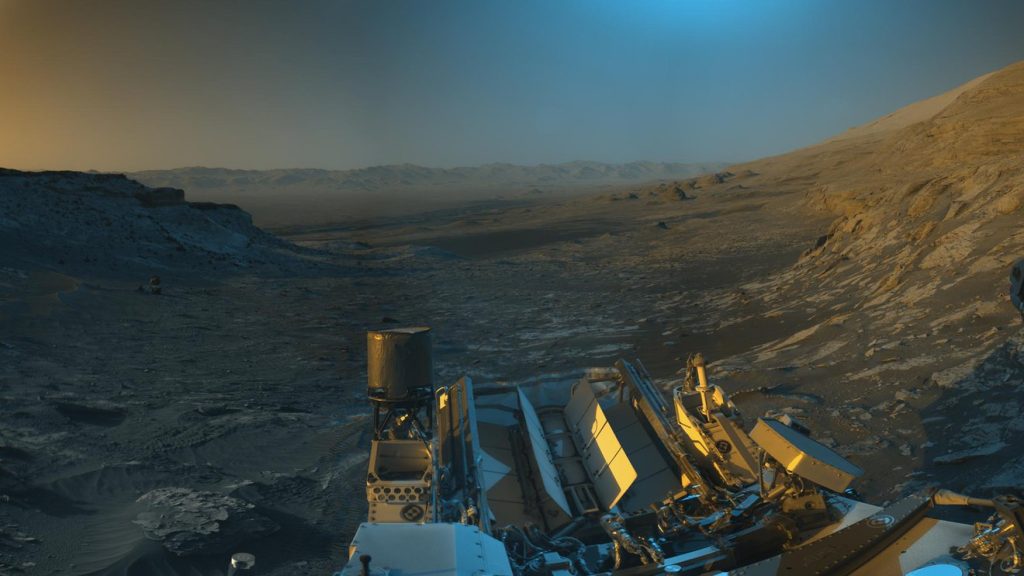
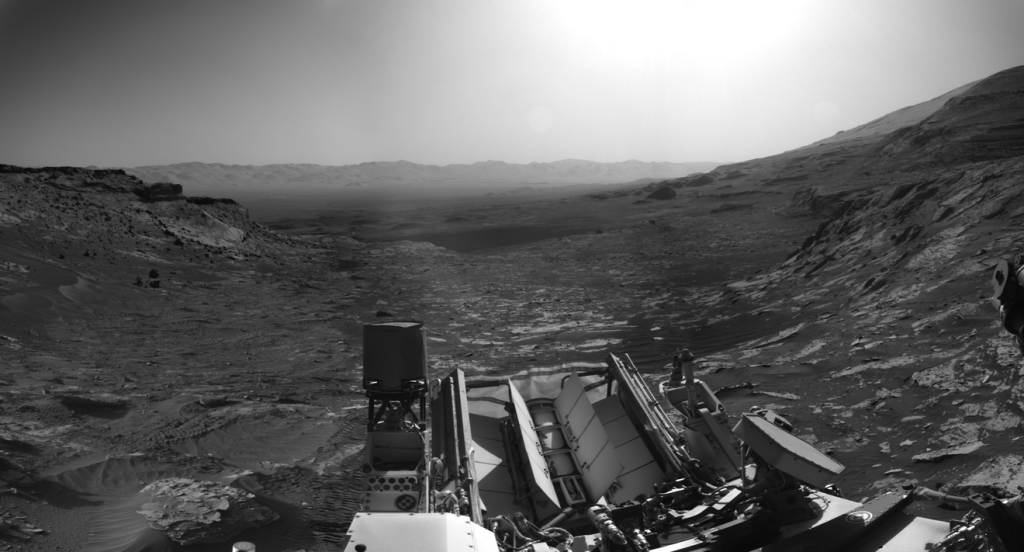 NASA’s Curiosity Mars rover used its navigation cameras to capture panoramas of this scene. Blue, orange, and green color was added to a combination of the panoramas for an artistic interpretation of the scene.
NASA’s Curiosity Mars rover used its navigation cameras to capture panoramas of this scene. Blue, orange, and green color was added to a combination of the panoramas for an artistic interpretation of the scene.
Credit: NASA/JPL-Caltech

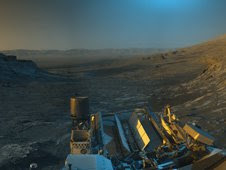 An artistic interpretation of Curiosity’s view high up on a Martian mountain was created by mission team members who were stunned by the sweeping landscape.
An artistic interpretation of Curiosity’s view high up on a Martian mountain was created by mission team members who were stunned by the sweeping landscape.
NASA’s Curiosity rover captured a remarkable image from its most recent perch on the side of Mars’ Mount Sharp. The mission team was so inspired by the beauty of the landscape, they combined two versions of the black-and-white images from different times of the day and added colors to create a rare postcard from the Red Planet.
Curiosity captures a 360-degree view of its surroundings with its black-and-white navigation cameras each time it completes a drive. To make the resulting panorama easier to send to Earth, the rover keeps it in a compressed, low-quality format. But when the rover team saw the view from Curiosity’s most recent stopping point, the scene was just too pretty not to capture it in the highest quality that the navigation cameras are capable of.
Many of the rover’s most stunning panoramas are from the color Mastcam instrument, which has far higher resolution than the navigation cameras. That’s why the team added colors of their own to this latest image. The blue, orange, and green tints are not what the human eye would see; instead, they represent the scene as viewed at different times of day.
On Nov. 16, 2021 (the 3,299th Martian day, or sol, of the mission), engineers commanded Curiosity to take two sets of mosaics, or composite images, capturing the scene at 8:30 a.m. and again at 4:10 p.m. local Mars time. The two times of day provided contrasting lighting conditions that brought out a variety of landscape details. The team then combined the two scenes in an artistic re-creation that includes elements from the morning scene in blue, the afternoon scene in orange, and a combination of both in green.
At the center of the image is the view back down Mount Sharp, the 3-mile-tall (5-kilometer-tall) mountain that Curiosity has been driving up since 2014. Rounded hills can be seen in the distance at center-right; Curiosity got a closer view of these back in July, when the rover started to see intriguing changes in the landscape. A field of sand ripples known as the “Sands of Forvie” stretches a quarter- to a half-mile (400 to 800 meters) away.
At the far right of the panorama is the craggy “Rafael Navarro Mountain,” named after a Curiosity team scientist who passed away earlier this year. Poking up behind it is the upper part of Mount Sharp, far above the area Curiosity is exploring. Mount Sharp lies inside Gale Crater, a 96-mile-wide (154-kilometer-wide) basin formed by an ancient impact; Gale Crater’s distant rim stands 7,500 feet tall (2.3 kilometers), and is visible on the horizon about 18 to 25 miles away (30 to 40 kilometers).
The Curiosity mission is led by NASA’s Jet Propulsion Laboratory, which is managed by Caltech in Pasadena, California.
For more information, please visit the following links:
https://mars.nasa.gov/msl/home/
and
https://www.nasa.gov/mission_pages/msl/index.html
News Media Contact
Andrew Good
Jet Propulsion Laboratory, Pasadena, Calif.
818-393-2433
Karen Fox / Alana Johnson
NASA Headquarters, Washington
301-286-6284 / 202-358-1501
karen.c.fox@nasa.gov / alana.r.johnson@nasa.gov
2021-232
| New Deep Learning Method Adds 301 Planets to Kepler’s Total Count Scientists have added a whopping 301 newly confirmed exoplanets to the total exoplanet tally. › Read the full story |
New Deep Learning Method Adds 301 Planets to Kepler’s Total Count
Nov 22, 2021
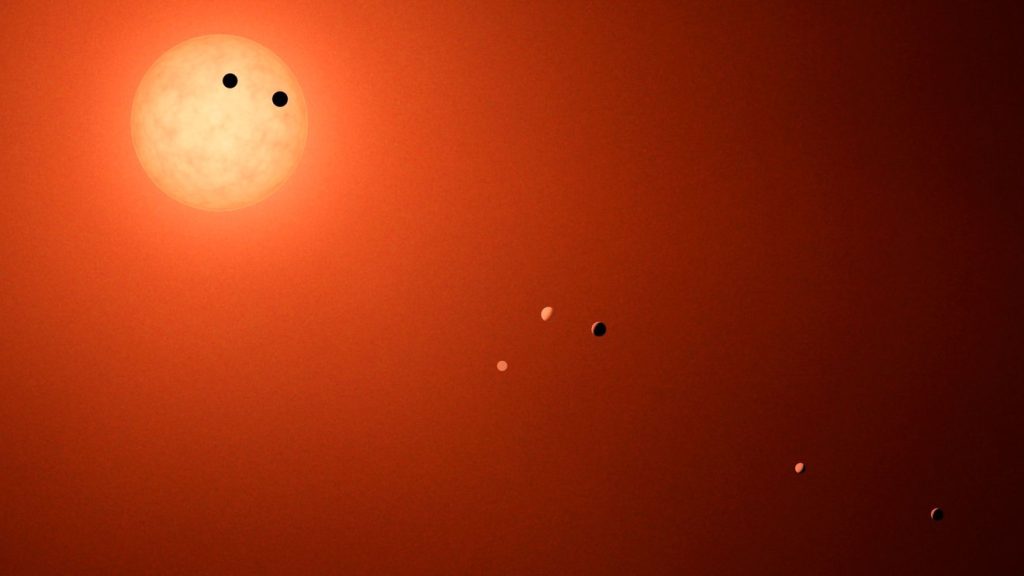 Over 4,5000 planets have been found around other stars, but scientists expect that our galaxy contains millions of planets. There are multiple methods for detecting these small, faint bodies around much larger, bright stars.
Over 4,5000 planets have been found around other stars, but scientists expect that our galaxy contains millions of planets. There are multiple methods for detecting these small, faint bodies around much larger, bright stars.
Credit: NASA/JPL-Caltech
Scientists have added a whopping 301 newly confirmed exoplanets to the total exoplanet tally.
Scientists recently added a whopping 301 newly validated exoplanets to the total exoplanet tally. The throng of planets is the latest to join the 4,569 already validated planets orbiting a multitude of distant stars. How did scientists discover such a huge number of planets, seemingly all at once? The answer lies with a new deep neural network called ExoMiner.
 When a planet crosses directly between us and its star, we see the star dim slightly because the planet is blocking out a portion of the light. This is one method scientists use to find exoplanets. They make a plot called a light curve with the brightness of the star versus time. Using this plot, scientists can see what percentage of the star’s light the planet blocks and how long it takes the planet to cross the disk of the star.
When a planet crosses directly between us and its star, we see the star dim slightly because the planet is blocking out a portion of the light. This is one method scientists use to find exoplanets. They make a plot called a light curve with the brightness of the star versus time. Using this plot, scientists can see what percentage of the star’s light the planet blocks and how long it takes the planet to cross the disk of the star.
Credit: NASA’s Goddard Space Flight Center
Deep neural networks are machine learning methods that automatically learn a task when provided with enough data. ExoMiner is a new deep neural network that leverages NASA’s Supercomputer, Pleiades, and can distinguish real exoplanets from different types of imposters, or “false positives.” Its design is inspired by various tests and properties human experts use to confirm new exoplanets. And it learns by using past confirmed exoplanets and false positive cases.
ExoMiner supplements people who are pros at combing through data and deciphering what is and isn’t a planet. Specifically, data gathered by NASA’s Kepler spacecraft and K2, its follow-on mission. For missions like Kepler, with thousands of stars in its field of view, each holding the possibility to host multiple potential exoplanets, it’s a hugely time-consuming task to pore over massive datasets. ExoMiner solves this dilemma.
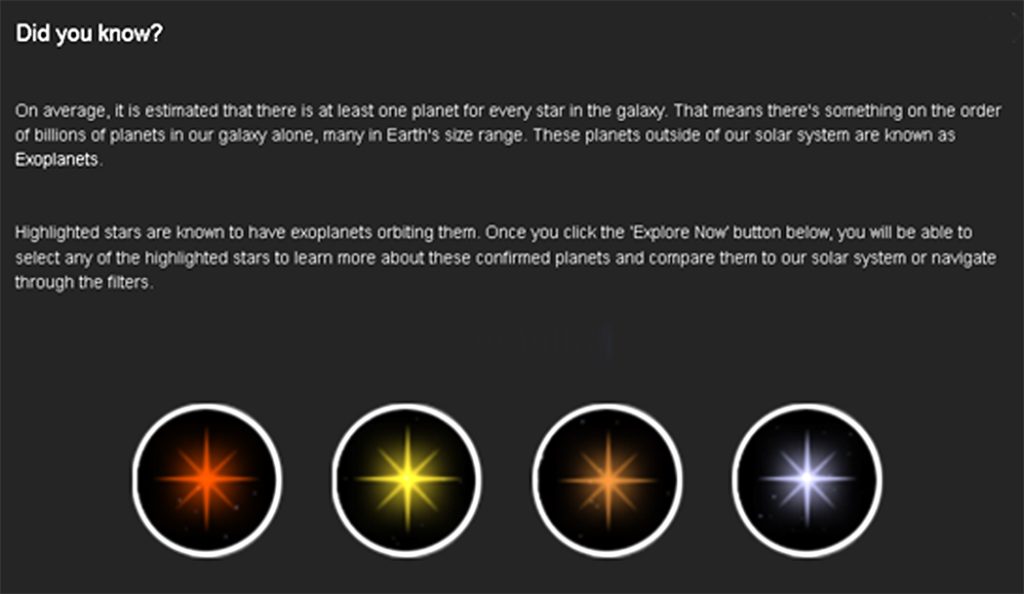
 NASA’s Eyes on Exoplanets shows the location of over 4,500 planets around other stars outside our solar system. Users can also see information about the physical features of the planets (where known) and the stars they orbit. View the full interactive experience at Eyes on Exoplanets.
NASA’s Eyes on Exoplanets shows the location of over 4,500 planets around other stars outside our solar system. Users can also see information about the physical features of the planets (where known) and the stars they orbit. View the full interactive experience at Eyes on Exoplanets.
“Unlike other exoplanet-detecting machine learning programs, ExoMiner isn’t a black box – there is no mystery as to why it decides something is a planet or not,” said Jon Jenkins, exoplanet scientist at NASA’s Ames Research Center in California’s Silicon Valley. “We can easily explain which features in the data lead ExoMiner to reject or confirm a planet.”
What is the difference between a confirmed and validated exoplanet? A planet is “confirmed,” when different observation techniques reveal features that can only be explained by a planet. A planet is “validated” using statistics – meaning how likely or unlikely it is to be a planet based on the data.
In a paper published in the Astrophysical Journal, the team at Ames shows how ExoMiner discovered the 301 planets using data from the remaining set of possible planets – or candidates – in the Kepler Archive. All 301 machine-validated planets were originally detected by the Kepler Science Operations Center pipeline and promoted to planet candidate status by the Kepler Science Office. But until ExoMiner, no one was able to validate them as planets.
The paper also demonstrates how ExoMiner is more precise and consistent in ruling out false positives and better able to reveal the genuine signatures of planets orbiting their parent stars – all while giving scientists the ability to see in detail what led ExoMiner to its conclusion.
“When ExoMiner says something is a planet, you can be sure it’s a planet,” added Hamed Valizadegan, ExoMiner project lead and machine learning manager with the Universities Space Research Association at Ames. “ExoMiner is highly accurate and in some ways more reliable than both existing machine classifiers and the human experts it’s meant to emulate because of the biases that come with human labeling.”
None of the newly confirmed planets are believed to be Earth-like or in the habitable zone of their parent stars. But they do share similar characteristics to the overall population of confirmed exoplanets in our galactic neighborhood.
“These 301 discoveries help us better understand planets and solar systems beyond our own, and what makes ours so unique,” said Jenkins.
As the search for more exoplanets continues – with missions using transit photometry such as NASA’s Transiting Exoplanet Survey Satellite, or TESS, and the European Space Agency’s upcoming PLAnetary Transits and Oscillations of stars, or PLATO, mission – ExoMiner will have more opportunities to prove it’s up to the task.
“Now that we’ve trained ExoMiner using Kepler data, with a little fine-tuning, we can transfer that learning to other missions, including TESS, which we’re currently working on,” said Valizadegan. “There’s room to grow.”
NASA Ames managed the Kepler and K2 missions for NASA’s Science Mission Directorate. JPL managed Kepler mission development. Ball Aerospace & Technologies Corporation operates the flight system with support from the Laboratory for Atmospheric and Space Physics at the University of Colorado in Boulder.
For more information, please visit the following links:
News Media Contact
Rachel Hoover
650-604-4789
Calla Cofield
Jet Propulsion Laboratory, Pasadena, Calif.
626-808-2469
2021-231
| NASA’s Perseverance Captures Challenging Flight by Mars Helicopter Recently downlinked imagery of a September flight has allowed the rover imaging team to put together a video of rotorcraft performing to near-perfection. › Read the full story |
Challenging Flight by Mars Helicopter
Nov 18, 2021
Ingenuity Mars Helicopter’s Flight 13: Zoomed-In View From Perseverance
Unlisted
Nov 17, 2021 JPLraw
Video from the Mastcam-Z instrument aboard NASA’s Perseverance Mars rover captures a closeup view of the 13th flight of the agency’s Ingenuity Mars Helicopter, on Sept. 4, 2021. For more information about Perseverance: mars.nasa.gov/mars2020/ nasa.gov/perseverance Credits: NASA/JPL-Caltech/ASU/MSSS
Recently downlinked imagery of a September flight has allowed the rover imaging team to put together a video of rotorcraft performing to near-perfection.
Video from the Mastcam-Z instrument aboard NASA’s Perseverance Mars rover captures a closeup view of the 13th flight of the agency’s Ingenuity Mars Helicopter, on Sept. 4, 2021.
Credit: NASA/JPL-Caltech/ASU/MSSS
Video footage from NASA’s Perseverance Mars rover of the Ingenuity Mars Helicopter’s 13th flight on Sept. 4 provides the most detailed look yet of the rotorcraft in action.
Ingenuity is currently prepping for its 16th flight, scheduled to take place no earlier than Saturday, Nov. 20, but the 160.5-second Flight 13 stands out as one of Ingenuity’s most complicated. It involved flying into varied terrain within the “Séítah” geological feature and taking images of an outcrop from multiple angles for the rover team. Acquired from an altitude of 26 feet (8 meters), the images complement those collected during Flight 12, providing valuable insight for Perseverance scientists and rover drivers.
Captured by the rover’s two-camera Mastcam-Z, one video clip of Flight 13 shows a majority of the 4-pound (1.8-kilogram) rotorcraft’s flight profile. The other provides a closeup of takeoff and landing, which was acquired as part of a science observation intended to measure the dust plumes generated by the helicopter.
“The value of Mastcam-Z really shines through with these video clips,” said Justin Maki, deputy principal investigator for the Mastcam-Z instrument at NASA’s Jet Propulsion Laboratory in Southern California. “Even at 300 meters [328 yards] away, we get a magnificent closeup of takeoff and landing through Mastcam-Z’s ‘right eye.’ And while the helicopter is little more than a speck in the wide view taken through the ‘left eye,’ it gives viewers a good feel for the size of the environment that Ingenuity is exploring.”
Video footage from the Mastcam-Z instrument aboard NASA’s Perseverance Mars rover provides a big-picture perspective of the 13th flight of the agency’s Ingenuity Mars Helicopter, on Sept. 4, 2021.
Credit: NASA/JPL-Caltech/ASU/MSSS
During takeoff, Ingenuity kicks up a small plume of dust that the right camera, or “eye,” captures moving to the right of the helicopter during ascent. After its initial climb to planned maximum altitude of 26 feet (8 meters), the helicopter performs a small pirouette to line up its color camera for scouting. Then Ingenuity pitches over, allowing the rotors’ thrust to begin moving it horizontally through the thin Martian air before moving offscreen. Later, the rotorcraft returns and lands in the vicinity of where it took off. The team targeted a different landing spot – about 39 feet (12 meters) from takeoff – to avoid a ripple of sand it landed on at the completion of Flight 12.
Though the view from Mastcam-Z’s left eye shows less of the helicopter and more of Mars than the right, the wide angle provides a glimpse of the unique way that the Ingenuity team programmed the flight to ensure success.
“We took off from the crater floor and flew over an elevated ridgeline before dipping into Séítah,” said Ingenuity Chief Pilot Håvard Grip of JPL. “Since the helicopter’s navigation filter prefers flat terrain, we programmed in a waypoint near the ridgeline, where the helicopter slows down and hovers for a moment. Our flight simulations indicated that this little ‘breather’ would help the helicopter keep track of its heading in spite of the significant terrain variations. It does the same on the way back. It’s awesome to actually get to see this occur, and it reinforces the accuracy of our modeling and our understanding of how to best operate Ingenuity.”
Ingenuity Mars Helicopter’s 13th Flight: Wide-Angle Video From Perseverance (Annotated)
Unlisted
Nov 17, 2021 JPLraw
Video footage from the Mastcam-Z instrument aboard NASA’s Perseverance Mars rover provides a big-picture perspective of the 13th flight of the agency’s Ingenuity Mars Helicopter, on Sept. 4, 2021. For more information about Perseverance: mars.nasa.gov/mars2020/ nasa.gov/perseverance Credits: NASA/JPL-Caltech/ASU/MSSS
The wide-angle view also shows how Ingenuity maintains altitude during the flight. After an initial ascent to 26 feet (8 meters) altitude, the helicopter’s laser altimeter notes a change in elevation of the terrain below as it heads northeast toward the ridgeline. Ingenuity automatically adjusts, climbing slightly as it approaches the ridge and then descending to remain 26 feet (8 meters) above the undulating surface. Once it flies to the right, out of view, Ingenuity collects 10 images of the rocky outcrop with its color camera before heading back into frame and returning to land in the targeted location.
After Flight 13, Ingenuity went quiet in October, along with NASA’s other Mars spacecraft during Mars solar conjunction, when the Red Planet and Earth are on opposite sides of the Sun, precluding most communications. Following conjunction, Ingenuity performed a short experimental flight test before undertaking Flight 15, which began the multi-flight journey back to the vicinity of “Wright Brothers Field,” its starting point back in April.
More About Ingenuity
The Ingenuity Mars Helicopter was built by JPL, which also manages the operations demonstration activity during its extended mission for NASA Headquarters. It is supported by NASA’s Science, Aeronautics Research, and Space Technology mission directorates. NASA’s Ames Research Center in California’s Silicon Valley, and NASA’s Langley Research Center in Hampton, Virginia, provided significant flight performance analysis and technical assistance during Ingenuity’s development. AeroVironment Inc., Qualcomm, and SolAero also provided design assistance and major vehicle components. Lockheed Martin Space designed and manufactured the Mars Helicopter Delivery System.
More About Perseverance
A key objective for Perseverance’s mission on Mars is astrobiology, including the search for signs of ancient microbial life. The rover will characterize the planet’s geology and past climate, pave the way for human exploration of the Red Planet, and be the first mission to collect and cache Martian rock and regolith.
Subsequent NASA missions, in cooperation with ESA (European Space Agency), would send spacecraft to Mars to collect these sealed samples from the surface and return them to Earth for in-depth analysis.
The Mars 2020 Perseverance mission is part of NASA’s Moon to Mars exploration approach, which includes Artemis missions to the Moon that will help prepare for human exploration of the Red Planet.
JPL, which is managed for NASA by Caltech in Pasadena, California, built and manages operations of the Perseverance rover.
For more information, please visit the following links:
For more about Perseverance:
and
News Media Contact
DC Agle
Jet Propulsion Laboratory, Pasadena, Calif.
818-393-9011
Karen Fox / Alana Johnson
NASA Headquarters, Washington
301-286-6284 / 202-358-1501
karen.c.fox@nasa.gov / alana.r.johnson@nasa.gov
2021-230
| One Year From Launch: US-European Satellite to Track World’s Water The Surface Water and Ocean Topography spacecraft enters the home stretch as an international team prepares this next-generation satellite for launch in 2022. › Read the full story |
Satellite to Track World’s Water
Nov 17, 2021
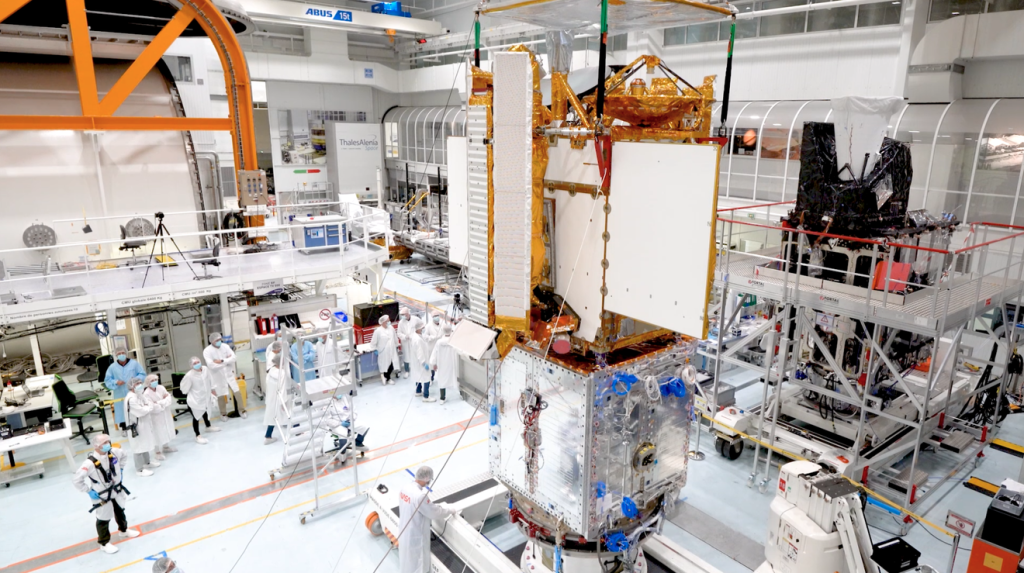 Engineers integrate separate parts of the SWOT satellite into one in a clean room facility in Cannes, France.
Engineers integrate separate parts of the SWOT satellite into one in a clean room facility in Cannes, France.
Credit: Thales Alenia Space
 The Surface Water and Ocean Topography spacecraft enters the home stretch as an international team prepares this next-generation satellite for launch in 2022.
The Surface Water and Ocean Topography spacecraft enters the home stretch as an international team prepares this next-generation satellite for launch in 2022.
An international team of engineers and technicians has finished assembling a next-generation satellite that will make the first global survey of Earth’s surface water and study fine-scale ocean currents. The Surface Water and Ocean Topography (SWOT) mission is just a year out from launch, and the final set of tests on the spacecraft have started.
SWOT is a collaboration between NASA and the French space agency Centre National d’Etudes Spatiales (CNES), with contributions from the Canadian Space Agency (CSA) and the United Kingdom Space Agency (UK Space Agency). The SUV-size satellite will collect data on the height of Earth’s salt- and fresh water – including oceans, lakes, and rivers – enabling researchers to track the volume and location of water around the world.
“SWOT will be our first global snapshot of all surface water that we have now, how the water moves around the planet, and what happens to it in a new climate.”
Nadya Vinogradova Shiffer, SWOT Program Scientist
SWOT will help to measure the effects of climate change on the planet’s water, such as the processes by which small, swirling ocean currents absorb excess heat, moisture, and greenhouse gases like carbon dioxide from the atmosphere. The mission’s measurements will also aid in following how much water flows into and out of the planet’s lakes, rivers, and reservoirs, as well as regional shifts in sea level.
“SWOT will be our first global snapshot of all surface water that we have now, how the water moves around the planet, and what happens to it in a new climate,” said Nadya Vinogradova Shiffer, SWOT program scientist at NASA Headquarters in Washington.
A team at the agency’s Jet Propulsion Laboratory in Southern California shipped the scientific heart of the satellite to Cannes, France, in June. Ever since, they’ve been working with colleagues from CNES and the French space agency’s contractor, Thales Alenia Space, to connect the part of the spacecraft holding the science instruments to the rest of the satellite and ensure that the electrical connections function properly.
“The best part has been seeing two complex systems that were built across the world from each other by different teams come together and work,” said JPL’s Said Kaki, the deputy project manager for SWOT. Kaki, along with an initial team of about 25 people from JPL, followed the mission’s science instruments to France in June. There are certain tests and procedures that the team needs to conduct in person, so they are living and working thousands of miles from home until the SWOT satellite is shipped to its launch site at Vandenberg Space Force Base in Central California in September 2022.
“Being far away from home for so long is not always easy, but luckily, I’m surrounded by amazing coworkers,” Nacer Chahat, the JPL payload system engineer for the mission, said from Cannes. He has been onsite overseeing the spacecraft testing and helping to troubleshoot any challenges that arise.
Testing Phase
The next six months or so will involve three phases of testing to make sure the satellite will be able to survive the rigors of launch and the harsh environment of space. Engineers and technicians will attach the satellite to a device called a shake table, which simulates the intense vibrations and rattling of launch. Then the spacecraft will move into an acoustic chamber to bombard it with high-decibel sounds similar to those of blastoff. Next, they’ll move SWOT into a chamber that mimics the temperature swings and vacuum of space. Last but not least, engineers will put the satellite through additional tests to make sure its systems can withstand any electromagnetic interference, including signals from various parts of the spacecraft and from other satellites.
“After that, we button up the spacecraft and ship it to the launch site,” said Kaki. At Vandenberg, the team will put the finishing touches on the satellite to ready it for launch, which is scheduled for no earlier than November 2022.
The mission’s science team is also in full swing, preparing for when the spacecraft is in orbit. Researchers are using simulated data to put their analytic tools through their paces, as well as prepping for the period right after launch called “calibration and validation.” This is when researchers compare data from the satellite with measurements taken on the ground in order to ensure the science instruments are collecting data properly and measuring what they’re supposed to be measuring.
The international nature of the mission means that, like the engineering team, the science team spans continents. “The best part of my job as the mission’s project scientist is being able to work with a large international research team with diverse interests and backgrounds in oceanography and hydrology,” said Lee-Lueng Fu, the JPL project scientist for SWOT. “This experience has broadened the horizon of my scientific career even after 40 years of devotion to Earth research.”
More About the Mission
SWOT is being jointly developed by NASA and CNES, with contributions from the CSA and the UK Space Agency. JPL, which is managed for NASA by Caltech in Pasadena, California, leads the U.S. component of the project. For the flight system payload, NASA is providing the Ka-band Radar Interferometer (KaRIn) instrument, a GPS science receiver, a laser retroreflector, and a two-beam microwave radiometer. CNES is providing the Doppler Orbitography and Radioposition Integrated by Satellite (DORIS) system, nadir altimeter, the KaRIn RF subsystem (with support from the UK Space Agency), the platform, and ground control segment. CSA is providing the KaRIn high-power transmitter assembly. NASA is providing associated launch services.
For more information, please visit the following links:
To learn more about the mission, visit:
Check Our Planet’s Vital Signs With NASA’s Eyes on the Earth
News Media Contact
Jane J. Lee / Ian J. O’Neill
Jet Propulsion Laboratory, Pasadena, Calif.
818-354-0307 / 818-354-2649
jane.j.lee@jpl.nasa.gov / ian.j.oneill@jpl.nasa.gov
2021-229
| Twin of NASA’s Perseverance Mars Rover Begins Terrain Tests OPTIMISM, the full-scale engineering model of Perseverance, begins a series of rigorous tests to assess the risk of potential driving hazards on the surface of the Red Planet. › Read the full story |
Twin of NASA’s Perseverance Mars Rover Begins Terrain Tests
Nov 17, 2021
Updated with new features, the twin of NASA’s Perseverance Mars rover arrives at JPL’s Mars Yard garage on October 29, 2021.
Credit: NASA/JPL-Caltech
OPTIMISM, the full-scale engineering model of Perseverance, begins a series of rigorous tests to assess the risk of potential driving hazards on the surface of the Red Planet.
On a recent day in November, the car-size rover rolled slowly forward, then stopped, perched on the threshold of a Martian landscape. But this rover, named OPTIMISM, wasn’t on the Red Planet. And the landscape was a boulder-strewn mock-up of the real Mars – the Mars Yard at NASA’s Jet Propulsion Laboratory in Southern California.
OPTIMISM, a twin of the Perseverance rover that is exploring Jezero Crater on Mars, will perform a crucial job in the weeks ahead: navigating the Mars Yard’s slopes and hazards, drilling sample cores from boulders, and storing the samples in metal tubes – just like Perseverance is doing in its hunt for signs of ancient microbial life. Short for Operational Perseverance Twin for Integration of Mechanisms and Instruments Sent to Mars, OPTIMISM is more generically known as a vehicle system test bed, and the recently upgraded rover begins testing out new equipment for the first time this month.
The tests help ensure that OPTIMISM’s twin on Mars can safely execute the commands sent by controllers on Earth. They also could potentially reveal unexpected problems Perseverance might encounter.
Get the Latest JPL News
“The size and shape of rocks in the visual field – will they turn into obstacles or not?” said Bryan Martin, the flight software and test beds manager at JPL. “We test a lot of that, figure out what kinds of things to avoid. What we have safely traversed around here has informed rover drivers in planning their traverses on Mars. We’ve done so much testing on the ground we can be confident in it. It works.”
About as long as a doubles tennis court and twice as wide, the Mars Yard has served as a testing ground for many a fully-engineered rover twin – from the engineering model of the very first, tiny Sojourner that landed on Mars in 1997 to the Spirit and Opportunity missions that began in 2004 to the Curiosity and Perseverance rovers exploring Mars today.
In each case, a rover double has scaled slopes, dodged obstacles, or helped rover planners puzzle out new paths on the simulated patch of Mars. OPTIMISM first rolled out into the Mars Yard in September 2020, when it conducted mobility tests.
But it recently received some key updates to match features available on Perseverance, including additional mobility software and the bulk of the exquisitely complex sample caching system. And while the team has already performed tests using the coring drill at the end of OPTIMISM’s robotic arm, they’ll be testing the newly installed Adaptive Caching Assembly for the first time in the Mars Yard. The assembly on Perseverance is responsible for storing rock and sediment samples. Some or all of these initial samples could be among those returned to Earth by a future mission.
“Now we can do it end-to-end in the test bed,” said the Vehicle System Ted Bed systems engineering lead, Jose G. Trujillo-Rojas. “Drill into the rock, collect the core sample, and now we have the mechanism responsible to cache that sample in the cylinder.”
And if problems arise on Perseverance on Mars, OPTIMISM can be used as a platform to figure out what went wrong and also how to fix it.
Twin Twins
On this November day, a heavy-duty vehicle transported OPTIMISM from a JPL test lab to the Mars Yard garage. Recently expanded, the structure also provides shelter to one of Curiosity’s Earthly counterparts: MAGGIE, or Mars Automated Giant Gizmo for Integrated Engineering. A second Curiosity double, a skeletal version called “Scarecrow” that lacks a computer brain, is housed in a separate shed in the Mars Yard.
MAGGIE would be joining OPTIMISM in the Mars Yard garage in the days ahead.
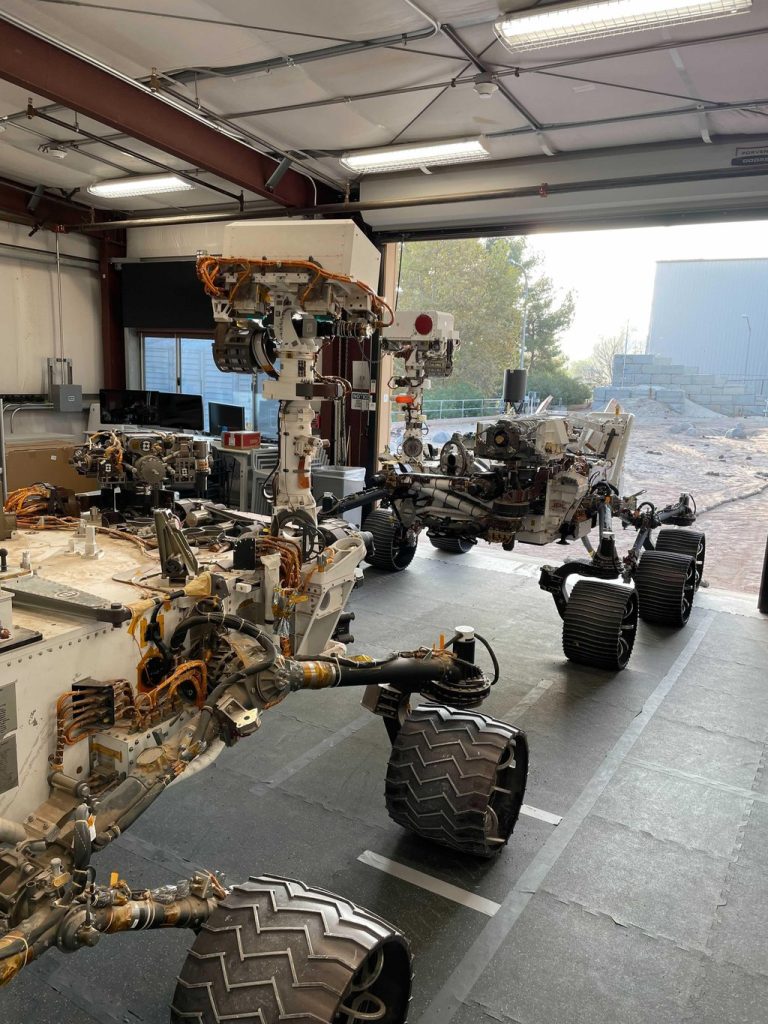 Engineering models of the Curiosity Mars rover (foreground) and the Perseverance Mars rover share space in the garage at JPL’s Mars Yard.
Engineering models of the Curiosity Mars rover (foreground) and the Perseverance Mars rover share space in the garage at JPL’s Mars Yard.
Credit: NASA/JPL-Caltech
But, for now, the test-bed crew was focused on OPTIMISM. “Straight 5 meters forward: Ready?” Leann Bowen, a test bed engineer, called out from a computer console inside the garage.
“All right, bring her home, Leann,” Trujillo-Rojas said.
With a whine of electric motors, OPTIMISM crept forward on its six metal wheels, stopping right on the mark on the garage’s concrete floor as members of the test-bed team looked on in their white lab coats. Through a wide-open door ahead of the rover, the Mars Yard beckoned.
Drilling core samples from terrestrial rocks in the Mars Yard and sealing them in metal tubes is not as straightforward as it might sound. JPL’s Mars team provides a variety of rock types for OPTIMISM to drill through, since the exact nature of the rock Perseverance will encounter often can’t be known in advance. Terrain is a variable, too: One previous test with the robotic arm involved parking the rover on a slope, then instructing it to drill.
“There was a possibility that the rover might slip,” Trujillo-Rojas said. “We wanted to test that first here on Earth before sending instructions to the rover on Mars. That was scary, because you can imagine if you drill this way, and the rover slightly slipped back, the drill could have gotten stuck.”
OPTIMISM drilled the core successfully, suggesting Perseverance also could pull off drilling on a slope if required.
Test Drive
With longer drives in Perseverance’s near future, another job for the Earth-bound twin will involve presenting new challenges to the rover’s autonomous navigation system, or AutoNav. Perseverance uses a powerful computer to make 3D maps using rover images of the terrain ahead, and uses those maps to plan its drive with minimal human assistance.
In Mars Yard tests, the twin rover might pause as it “thinks through” several possible choices – or even decides, unexpectedly, to avoid obstacles altogether and just go around.
“Seeing the rover autonomously move in the Mars Yard, you kind of get that sense of being connected to the rover on Mars,” he said. “It gives you that visual connection.”
Of course, OPTIMISM and its human team must contend with environmental factors very different from those encountered by Perseverance, which is built for freezing temperatures and intense radiation. Earth’s stronger gravity required OPTIMISM’s metal wheels to be thicker than its Martian counterpart’s. And its electronics sometimes must be cooled to avoid damage from Southern California’s summer temperatures – the opposite of the problem caused by deep cold on Mars.
“On Mars, we try to keep the rover warm,” Trujillo-Rojas said. “Here, we’re trying to keep it cool.”
Deer, bobcats, tarantulas, even occasional snakes, find their way into the Mars Yard. Wildfire in the region can fill the air with smoke. And testing and staffing schedules had to contend with COVID-19.
“We’ve been through a lot of challenges with this rover,” he said. “As soon as we were going to start building it, with hands-on integration, the pandemic happened. And then we had rains, and we got a lot of fire. We had to leave the lab – smoky!”
Now, a revamped OPTIMISM is ready to get back to work.
“It’s a big milestone for our team,” Trujillo-Rojas said.
More About the Mission
A key objective for Perseverance’s mission on Mars is astrobiology, including the search for signs of ancient microbial life. The rover will characterize the planet’s geology and past climate, pave the way for human exploration of the Red Planet, and be the first mission to collect and cache Martian rock and regolith (broken rock and dust).
Subsequent NASA missions, in cooperation with ESA (European Space Agency), would send spacecraft to Mars to collect these sealed samples from the surface and return them to Earth for in-depth analysis.
The Mars 2020 Perseverance mission is part of NASA’s Moon to Mars exploration approach, which includes Artemis missions to the Moon that will help prepare for human exploration of the Red Planet.
JPL, which is managed for NASA by Caltech in Pasadena, California, built and manages operations of the Perseverance rover.
For more information, please visit the following links:
For more about Perseverance:
and
Where Is Perseverance Right Now?
‘AR’ Mobile App Features 3D NASA Spacecraft
News Media Contact
DC Agle / Andrew Good
Jet Propulsion Laboratory, Pasadena, Calif.
818-393-9011 / 818-393-2433
agle@jpl.nasa.gov / andrew.c.good@jpl.nasa.gov
Karen Fox / Alana Johnson
NASA Headquarters, Washington
301-286-6284 / 202-358-1501
karen.c.fox@nasa.gov / alana.r.johnson@nasa.gov
Written by Pat Brennan
2021-228
This message was sent to ingpeaceproject@gmail.com from jplnewsroom@jpl.nasa.gov
NASA’s Jet Propulsion Laboratory
NASAJPL
4800 Oak Grove Dr
Pasadena, CA 91109
Live Feed of the Dec. 4, 2021 Total Solar Eclipse
Streamed live 23 hours ago 12.3.2021 NASA
Weather permitting, NASA TV will air a view of the Dec. 4, 2021, total solar eclipse from Union Glacier, Antarctica. The stream will start at 1:30 a.m. EST (06:30 UTC) and end at 3:37 a.m. EST (08:47 UTC). Totality begins at 2:44 a.m. EST (07:44 UTC). This stream is provided courtesy of Theo Boris and Christian Lockwood of the JM Pasachoff Antarctic Expedition. For more details about this total solar eclipse, visit https://www.nasa.gov/content/dec-4-20…. (The stream will not have audio from the source.)
NASA Announces 2021 Class of Astronaut Candidates
Streamed live on Dec 6, 2021 NASA
After evaluating more than 12,000 applications, we’ll introduce our 2021 astronaut candidates live at a ceremony at Ellington Field near NASA’s Johnson Space Center in Houston. After completing training, these women and men could be eligible for a variety of flight assignments including missions on and around the Moon under Artemis. The astronaut candidates will join NASA Administrator Bill Nelson, NASA Deputy Administrator Pam Melroy, Johnson Center Director Vanessa Wyche, and Flight Operations Director Norm Knight on stage at the event. More info: https://www.nasa.gov/press-release/na…


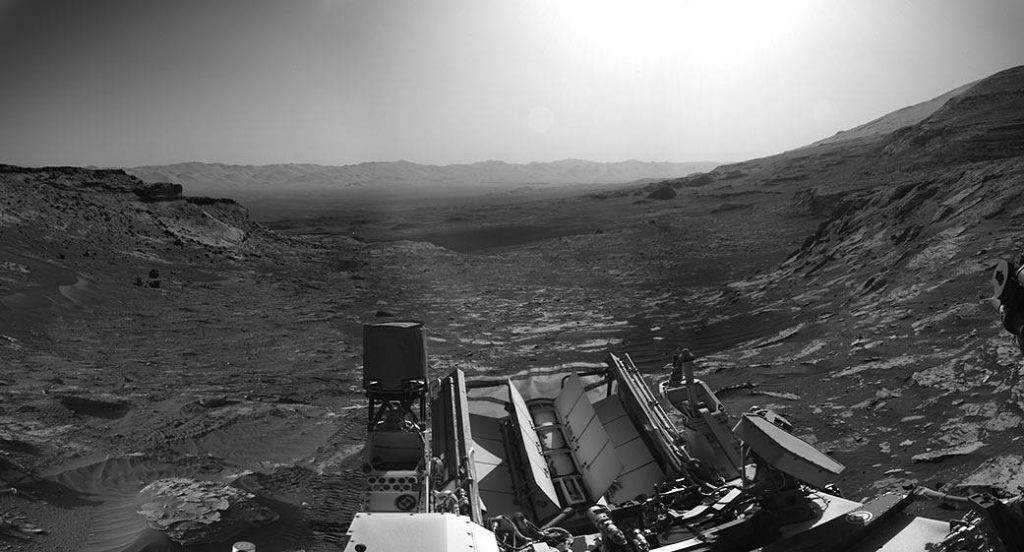
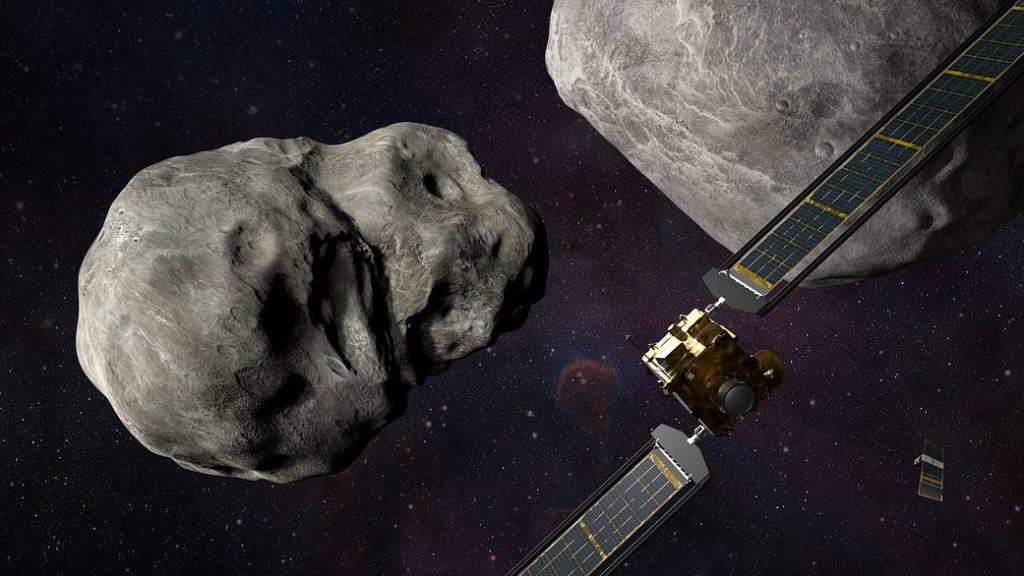

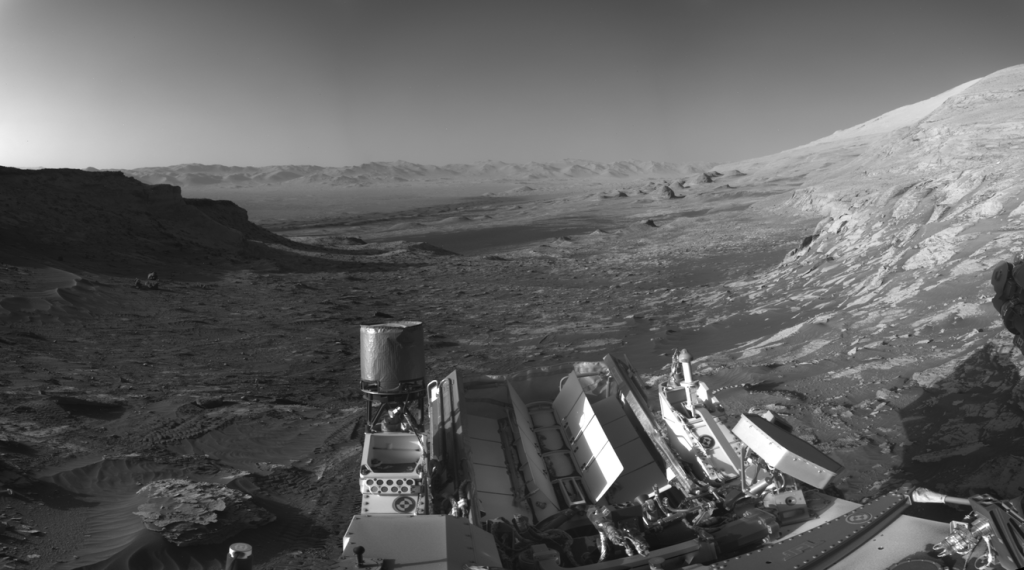
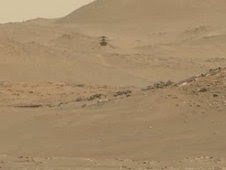
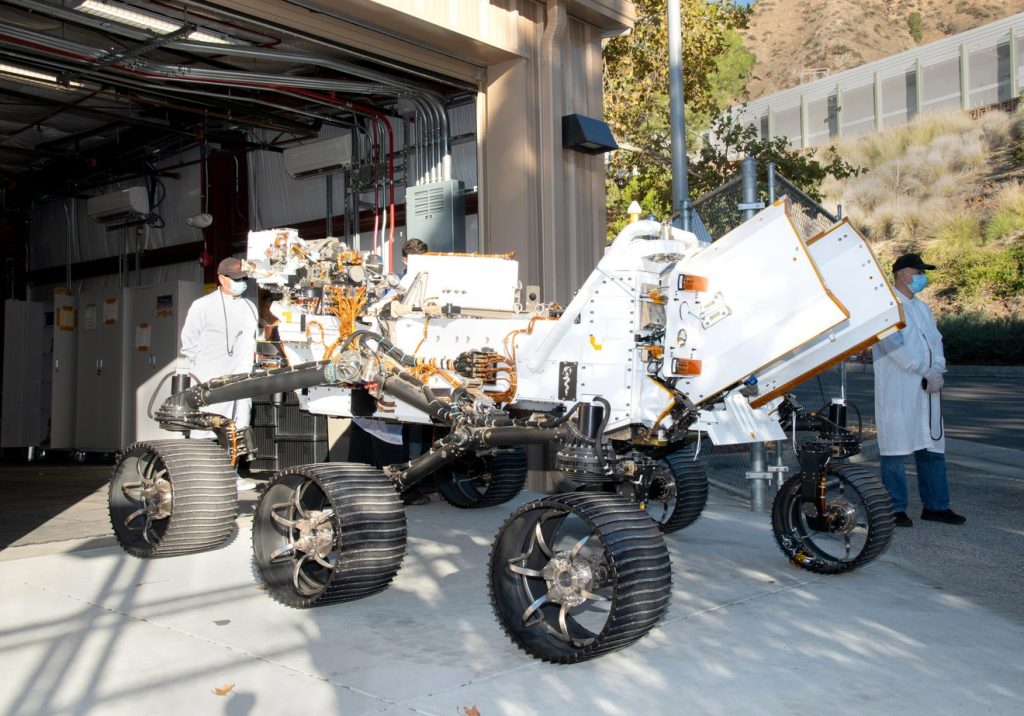

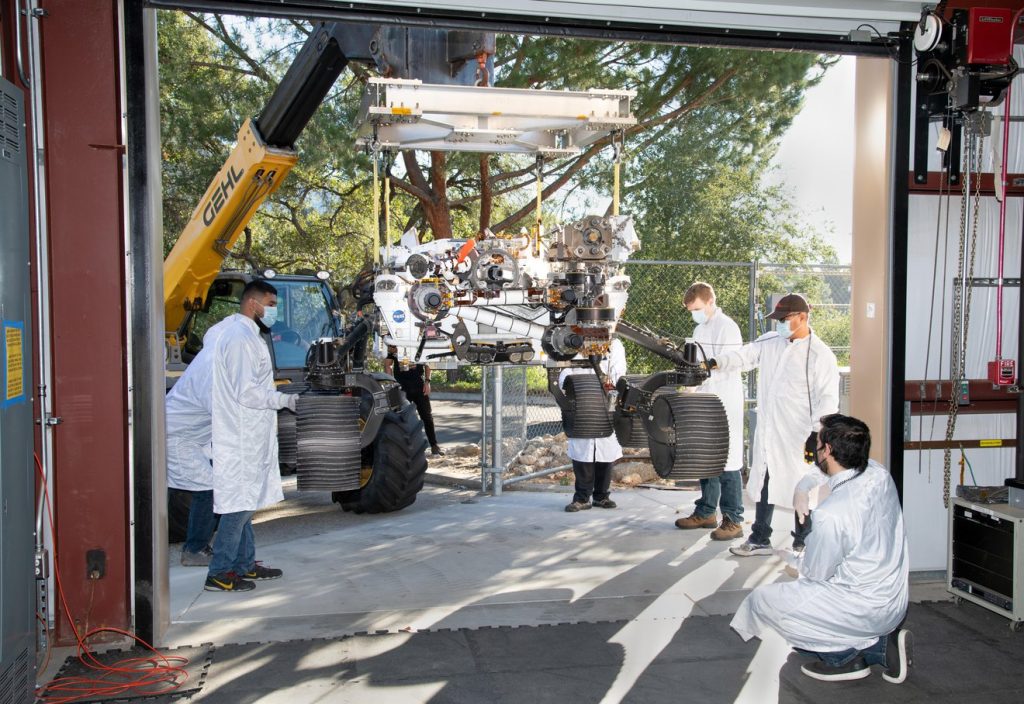
Leave a Reply